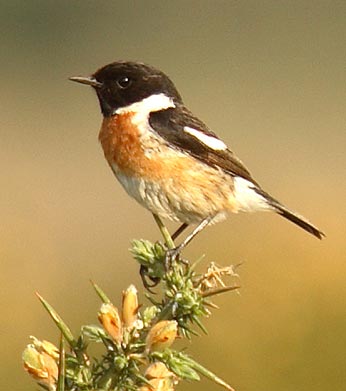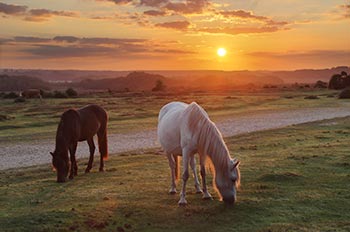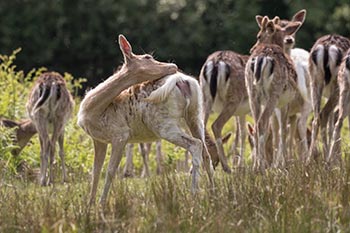Choosing binoculars - a binoculars guide

birds - such as this stonechat - are required
Choosing binoculars, the most appropriate binoculars, is important if maximum enjoyment is to be had whilst birdwatching or viewing other wildlife.
The main factors to consider when choosing binoculars include:
a) Magnification
b) Image brightness
c) Field of view
d) Depth of field
e) Size and weight
f) Cost
Fold down or retractable eye-cups are also essential for spectacle wearers, weather / water proofing is highly desirable, and so is the capability to focus one eyepiece separately from the other.
Rugged construction is also important – a rubber body covering, for example, adds protection. Close focusing capability is less of an issue for bird and mammal watching, although it is important if the binoculars are to be used to look at, say, dragonflies or butterflies. And of course, comfort and ease of use are also significant factors.
But when choosing binoculars and considering feature sets, compromise is likely to be required, as strength in one area sometimes has a detrimental knock-on effect in other areas. For example, high magnification is often associated with reduced in depth of field, reduced field of view and reduced image brightness, whilst an increase in lens size to increase image brightness often adds to overall size and weight. Consider the options, then, and buy to suit your own particular preferences.
Here’s an overview of the main factors to be considered when choosing binoculars:
Magnification
The numbers associated with binoculars indicate their magnification and the diameter in millimetres of the objective lens – the large, front lens. (A pair of 10x50 binoculars has 10x magnification and a 50 millimetres objective lens).
Those offering 8x or 10x magnification are most suitable for serious wildlife watching. They’re practical to hand-hold without image stability being too badly affected by shaking hands – over 10x magnification and a monopod or tripod is usually needed. They also offer the prospect of reasonable image size and brightness, and acceptable depth of field and field of view.
Image brightness
The diameter of the objective lens indicates the amount of light entering the binoculars. The light gathering potential and consequent image brightness and clarity can be broadly assessed by dividing binocular magnification by the diameter of the objective lens. For serious, sustained use, a result of at least 5 is desirable, particularly if the binoculars are to be regularly used in poor light; whilst for casual, maybe infrequent use - for example, to obtain a better view of birds in the garden - the result of this calculation for many will be less important than considerations of size, cost and convenience.
Be aware, though, that image brightness and clarity are also influenced by a) optical quality, and b) lens coatings designed to reduce reflected light. (Coatings, in sequence of effectiveness (and often price), are often marked as: C – coated; FC – fully coated; MC – multi-coated; and FMC or SMC - fully multi-coated).
Field of view
The field of view is the amount of circular viewing area seen – the side-to-side / top to bottom area in view at any one time. It is usually measured as an angle in degrees, or is given as the number of feet or metres visible at 1,000 yards. (Each degree corresponds to 52½ feet at 1000 yards - fields of view generally range from 5º (263 feet) to 11º (578 feet).
Field of view is of particular significance when it is potentially difficult to initially get the subject in view - for example, when watching birds at close quarters in dense foliage, or when viewing birds in flight.
Depth of field
Depth of field is the front to back distance that will be in clear focus at any one time. The greater the depth of field, the better; for the shallower the depth of field, the more difficult it is to quickly get subjects into focus, and keep them in focus.
Size and weight
Size and weight are also important, particularly if the binoculars are to be used for lengthy periods. And of course, the larger and heavier the binoculars, the more difficult it may be to hold them steady.
Cost
Many binocular models are available, ranging in cost from £30, or so, to well over £1,000 and it’s always as well to remember that buyers generally get what they pay for – the more expensive models are likely to be constructed of better quality materials and be more rugged. Equally, though, many people, particularly in good light, will notice little difference between mid-range and top of the range models.
Summary
Compared to binoculars offering 10x magnification, those of 8x magnification are likely to give a slightly better depth of field and field of view, and be smaller and lighter. Binoculars with 10x magnification do, though, offer larger image sizes, and are particularly suited for use when viewing over the wide open spaces of heathland, farmland, mudflats and the like.
Few people, though, spend all their time in one type of habitat to the exclusion of all others, so a balance much be struck to suit likely bird-watching needs. Of course, though, there’s no need to spend too much time agonising - 8x will do the job over the open spaces, and 10x will provide acceptable results when field of view and depth of field are important.
Then having bought, adjust the binoculars for personal use
Having purchased a pair of binoculars, it’s necessary to adjust them for personal use.
First set the eyepiece spacing. Use the hinge in the middle to set the distance between the eyepieces to match the distance between your eyes so that you see a full, round image through each individual eyepiece, and a single round image when both are used together, with no dark shadowing around the edge of either eyepiece.
Then, as most people have slightly different sight in each eye, set the binocular focusing accordingly. To do this, close the eye used at the focus-adjustable eyepiece, or put the lens cap on that side. Look at something in the distance through the other eye, and adjust the central focusing mechanism until the image is clear, then look at the same subject and use the individual eyepiece adjuster to set focus for that eye. Subsequently, all focusing can be done using the main, central focus control.
And finally….
I personally use, and am very happy with, mid-range 8 x 42 binoculars purchased in 2004 or 2005 from the RSPB and costing then around £300. They’re described as ‘Phase coated’, are waterproof, close focus to 7 or 8 feet, have a field of view of 6. 5º, are small, light, and offer excellent light gathering power.
In fact, in my view, RSPB binoculars generally offer good quality and excellent value for money, whilst purchase also makes a valuable contribution to a very worthwhile conservation charity.
Help me to help you (please)
Many pairs of binoculars, including RSPB models, are available through the Amazon website, where can be found full equipment specifications and customer reviews. Prices are usually extremely competitive, the ordering process is quick and easy, and delivery is typically fast.
Furthermore - important from my perspective - purchasing anything from Amazon via this link results in the receipt of a modest contribution towards the cost of developing and maintaining this free-to-use New Forest website which, unlike some other similar sites, is not funded by the local Council, the National Park Authority or through any other form of public taxation. (In essence, purchasing via this link costs you nothing and helps ensure that this site will be improved and maintained in the future.)
Quick linksMore links
Other related links
Search this site

Sadly, 58 animals were killed - 35 ponies, 13 cows, 8 donkeys and 2 sheep, whilst a further 32 were injured - 3 pigs, 9 donkeys, 11 cows and 9 ponies.
(Forty-three accidents occurred in daylight, 15 at twilight and 101 in the dark. Twenty-seven accidents were not reported by the driver involved).
Here's just one horrific example - Three donkeys killed in collision with van at notorious New Forest blackspot (Advertiser and Times)


Sika deer continue to engage in rutting behaviour, and will do so until December.
Pigs seek out the remains of the acorn crop.
Beech leaves are transformed into a magnificent mosaic of glorious reds and golds. Other deciduous trees, too, take on an autumnal cloak before their leaves fall.
Dragonflies can occasionally be seen on the wing on bright days early in the month.
December
Foxglove leaves survive the winter at ground level, and offer the prospect of colourful summer blooms to come.
Redwings and fieldfares, autumn and winter visitors, gorge on haws and holly berries.
Great grey shrikes and hen harriers hunt over the heaths and other open spaces.
Honeysuckle by the end of the month often shows welcome signs of new growth.

